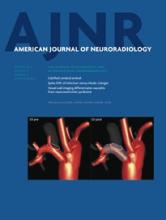Article CommentaryNeurointervention
Toward Improving Fidelity of Computational Fluid Dynamics Simulations: Boundary Conditions Matter
Christof Karmonik
American Journal of Neuroradiology August 2014, 35 (8) 1549-1550; DOI: https://doi.org/10.3174/ajnr.A3984
Christof Karmonik
aDepartments of Neurosurgery and Translational Imaging
Houston Methodist Hospital Research Institute
Houston, Texas
Weill Medical College of Cornell University
New York, New York

REFERENCES
- 1.↵
- Jansen IG,
- Schneiders JJ,
- Potters WV,
- et al
- 2.↵
- Karmonik C,
- Yen C,
- Diaz O,
- et al
- 3.↵
- Karmonik C,
- Yen C,
- Grossman RG,
- et al
- 4.↵
- 5.↵
- 6.↵
- 7.↵
- Byrne G,
- Mut F,
- Cebral J
- 8.↵
- Cebral JR,
- Mut F,
- Weir J,
- et al
- 9.↵
- Jou LD,
- Lee DH,
- Morsi H,
- et al
- 10.↵
- Jiang J,
- Strother C
- 11.↵
- Ford MD,
- Stuhne GR,
- Nikolov HN,
- et al
- 12.↵
- Endres J,
- Kowarschik M,
- Redel T,
- et al
- 13.↵
- 14.↵
- 15.↵
- Karmonik C,
- Klucznik R,
- Benndorf G
- 16.↵
- Karmonik C,
- Klucznik R,
- Benndorf G
- 17.↵
- Boussel L,
- Rayz V,
- Martin A,
- et al
- 18.↵
- Rayz VL,
- Boussel L,
- Acevedo-Bolton G,
- et al
- 19.↵
- Berg P,
- Stucht D,
- Janiga G,
- et al
- 20.↵
- 21.↵
- Cebral JR,
- Meng H
- 22.↵
- Kallmes DF
- 23.↵
- Strother CM,
- Jiang J
- 24.↵
- Hentschel S,
- Mardal KA,
- Lovgren AE,
- et al
- 25.↵
- Linge SO,
- Mardal KA,
- Haughton V,
- et al
- 26.↵
- Karmonik C,
- Chintalapani G,
- Redel T,
- et al
In this issue
American Journal of Neuroradiology
Vol. 35, Issue 8
1 Aug 2014
Advertisement
Christof Karmonik
Toward Improving Fidelity of Computational Fluid Dynamics Simulations: Boundary Conditions Matter
American Journal of Neuroradiology Aug 2014, 35 (8) 1549-1550; DOI: 10.3174/ajnr.A3984
0 Responses
Jump to section
Related Articles
- No related articles found.
Cited By...
- A Hemodynamic Mechanism Correlating with the Initiation of MCA Bifurcation Aneurysms
- Subject-Specific Studies of CSF Bulk Flow Patterns in the Spinal Canal: Implications for the Dispersion of Solute Particles in Intrathecal Drug Delivery
- Comparison of intracranial aneurysm flow quantification techniques: standard PIV vs stereoscopic PIV vs tomographic PIV vs phase-contrast MRI vs CFD
This article has not yet been cited by articles in journals that are participating in Crossref Cited-by Linking.
More in this TOC Section
Similar Articles
Advertisement











